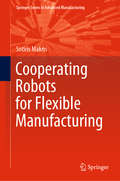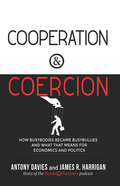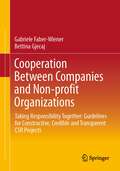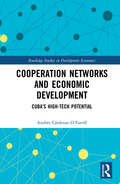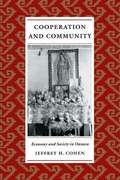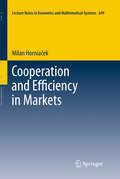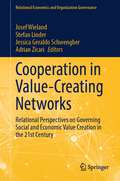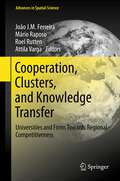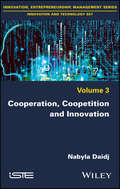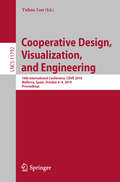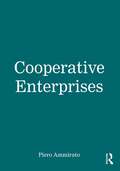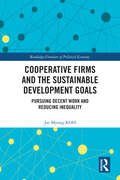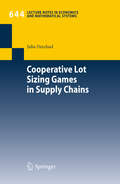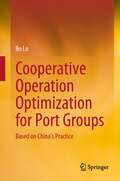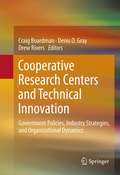- Table View
- List View
Coolfarming: Turn Your Great Idea into the Next Big Thing
by Peter GloorPursuing new ideas is clearly the way to gain business advantage in the new millennium. But it's not enough to simply chase after ideas that have already happened. To truly benefit, individuals and organizations have to foster the new creative impulses around them. Coolfarming shows readers how they, like bee keepers, can nurture exciting trends and unleash their creative swarm's output of "next big ideas." Featuring real life examples from Linux to Twilight, from Procter Gamble to Apple, Coolfarming provides readers with invaluable insight on how to: Provide a fertile nurturing ground for developing original ideas * Determine what "cool" means for one's target group, and what attributes the next big thing should possess * Convert creative dreams into real products by enlisting the help of a dedicated and passionate Collaborative Innovation Network * Carry new ideas over the tipping point into widespread phenomena Those who want to stay ahead of the curve and ride a wave of profit need to learn how to find, develop, and popularize the trends of tomorrow. Coolfarming is the answer.
Coop: Market Research
by Youngme Moon Ruth BoltonDaryl Buckmeister, CEO of The Chicken Coop, must decide whether to invest in market research, how much money to spend, and which programs to fund. His two vice presidents (of quality and marketing) have presented very different proposals.
Cooper Industries' Corporate Strategy (A)
by David J. Collis Toby StuartDescribes the development of a successful corporate strategy based on the acquisition and subsequent consolidation of low-technology manufacturing companies. Starting with a company history and discussion of current business segments, the case goes on to detail the innovation of corporate headquarters in strategy formulation and operations. Highlights the synergistic possibilities in alike acquisitions and addresses the issue of long-term value creation in acquisition-oriented firms. Emphasis is placed on the systems and procedures installed to implement the corporate strategy.
Cooper Industries' Corporate Strategy (B)
by Elizabeth Johnson David J. CollisBrings students up to date regarding a recent decision by the chairman.
Cooper Industries, Inc.
by Thomas R. PiperThe executive president of a major industrial company must decide 1) whether to acquire a small hand tool company and, if so, 2) the value and form that the acquisition package should take.
Cooper Pharmaceuticals, Inc.
by Frank V. CespedesTraces the 12-year career of a pharmaceutical salesperson, Bob Marsh, from recruitment to termination. Mr. Marsh has had an uneven career with Cooper Pharmaceuticals, Inc. (CPI) and, after a probationary period, is asked to resign. Following his termination, a number of Marsh's former customers complain vigorously, and CPI's vice president of sales is asked to investigate the matter and to decide what, if anything, to do about it. A rewritten version of an earlier case by D.A. Newton.
Cooperating Robots for Flexible Manufacturing (Springer Series in Advanced Manufacturing)
by Sotiris MakrisThis book consolidates the current state of knowledge on implementing cooperating robot-based systems to increase the flexibility of manufacturing systems. It is based on the concrete experiences of experts, practitioners, and engineers in implementing cooperating robot systems for more flexible manufacturing systems. Thanks to the great variety of manufacturing systems that we had the opportunity to study, a remarkable collection of methods and tools has emerged. The aim of the book is to share this experience with academia and industry practitioners seeking to improve manufacturing practice. While there are various books on teaching principles for robotics, this book offers a unique opportunity to dive into the practical aspects of implementing complex real-world robotic applications. As it is used in this book, the term “cooperating robots” refers to robots that either cooperate with one another or with people. The book investigates various aspects of cooperation in the context of implementing flexible manufacturing systems. Accordingly, manufacturing systems are the main focus in the discussion on implementing such robotic systems. The book begins with a brief introduction to the concept of manufacturing systems, followed by a discussion of flexibility. Aspects of designing such systems, e.g. material flow, logistics, processing times, shop floor footprint, and design of flexible handling systems, are subsequently covered. In closing, the book addresses key issues in operating such systems, which concern e.g. decision-making, autonomy, cooperation, communication, task scheduling, motion generation, and distribution of control between different devices. Reviewing the state of the art and presenting the latest innovations, the book offers a valuable asset for a broad readership.
Cooperating with Nature: Confronting Natural Hazards with Land-Use Planning for Sustainable Communities
by Raymond J. BurbyThis volume focuses on the breakdown in sustainability--the capacity of the planet to provide quality of life now and in the future--that is signaled by disaster. The authors bring to light why land use and sustainability have been ignored in devising public policies to deal with natural hazards. They lay out a vision of sustainability, concrete suggestions for policy reform, and procedures for planning. The book chronicles the long evolution of land-use planning and identifies key components of sustainable planning for hazards. Stressing the importance of balance in land use, the authors offer principles and specific reforms for achieving their visions of sustainability.
Cooperation & Coercion: How Busybodies Became Busybullies and What that Means for Economics and Politics
by Antony Davies James R HarriganThere are only two ways that humans work together: they cooperate with one another, or they coerce one another. And once you realize this fundamental fact, it will change how you see the world. In this myth-busting book, Antony Davies and James R. Harrigan display the wisdom and talent for explaining complex topics that have attracted a devoted audience to their weekly podcast, Words & Numbers, and made them popular speakers around the country. By looking for cooperation and coercion in everyday life, they help make sense of a wide range of issues that dominate the public debate. You&’ll come away from this book with a clear understanding of everything from the minimum wage to taxes, from gun control to government regulations, from the War on Terror to the War on Drugs to the War on Poverty. It turns out that coercion is necessary . . . sometimes. Even in a democracy, we all abide by rules, including plenty that we don&’t agree with, in the name of getting along. But in the end, Davies and Harrigan show, cooperation without question is the key to human happiness and progress. The more we encourage it, the better off we all are. Cooperation & Coercion cuts through heated partisan debates to provide a refreshingly clear and comprehensive understanding of the way the world works.
Cooperation Between Companies and Non-profit Organizations: Taking Responsibility Together: Guidelines for Constructive, Credible and Transparent CSR Projects
by Gabriele Faber-Wiener Bettina GjecajThis book describes how cooperation between companies and non-profit organizations can be successfully structured. Companies want and need to take on more social responsibility, and joint projects with non-profit organizations are therefore more in demand than ever. This is not about maximizing profits through greenwashing or token commitments, but about serious corporate social responsibility projects and purpose strategies that strengthen the reputation on both sides. This requires a structured, transparent approach from the outset.The authors explain the theoretical basis and provide practical guidance on how the initiation of cooperation projects can lead to a credible and sustainable collaboration with added value for all stakeholders. An elementary part of the book is the "Code for Transparent Cooperation", a proven framework that can be applied directly in practice.A book for CSR, communication, marketing and compliance managers in companiesand non-profit organizations who strive for clear rules and an open dialogue at eye level.Anyone who acts as a credible driver of transformation would do well to operate sustainably themselves. Transparency creates credibility and reliability. The more an organization's goals shape the design of partnerships with companies, the more authentic they can appear to the outside world. This guide provides helpful tips and orientation on how to achieve coherence.Dipl.theol. Yvonne Zwick, Chairwoman of B.A.U.M. e.V. - Network for Sustainable Management, HamburgNon-profit organizations are central pillars of our society. Especially in times of disruption and change, their performance is of increasing importance. The prerequisite for this is independence - also in cooperation with companies. This book helps companies and non-profit organizations to understand their counterparts and establish stable collaborations.Dr. Günther Lutschinger, Managing Director of Fundraising Association Austria, ViennaThe time for lone wolves is over. If we are to achieve the Paris climate targets, companies must offer profitable solutions for people and the planet. It's all about: How do I tackle it? The new book by Gabriele Faber-Wiener and Bettina Gjecaj focuses in particular on partnerships with non-profit organizations and aims to prepare the ground for successful collaboration.Daniela Knieling, Managing Director respACT and Network Representative Global Compact Network Austria, ViennaCredibility, responsibility and transparency are the guarantee and basis for the sustainable development of companies. A thriving, trusting cooperation between companies and non-profit organizations helps to answer political and social questions and is a profound approach to solving complex ecological problems.Ernst Ternon, MBA MSc MSc, Head of Green Marketing, Wieselburg Campus, Wiener Neustadt University of Applied Sciences
Cooperation Networks and Economic Development: Cuba’s High-Tech Potential (Routledge Studies in Development Economics)
by Andrés Cárdenas O´FarrillFor most Western audiences, Cuba is a touristic paradise stuck in time and virtually detached from world technology networks by the US embargo – anything but a hub of industrial innovation and high value-added biotechnology. However, a closer look reveals more subtle but equally powerful stories that challenge the homogenizing assumptions of conventional economics and open up scope for more sophisticated reflections on Cuban economy and industry. From this kind of enquiry emerges the case of the internationally respected Cuban biotech industry as the most successful case of science and technology policy in the country’s economic history. The book takes an interdisciplinary approach, exploring issues such as interdependency, purpose and history as natural constituencies of the innovation process. It also examines the dynamic and crucial role played by the state in the formation of innovative business enterprises. This book will be of interest to academic researchers in the fields of innovation and economic development.
Cooperation and Community: Economy and Society in Oaxaca
by Jeffrey H. CohenIn the villages and small towns of Oaxaca, Mexico, as in much of rural Latin America, cooperation among neighbors is essential for personal and community survival. It can take many forms, from godparenting to sponsoring fiestas, holding civic offices, or exchanging agricultural or other kinds of labor. This book examines the ways in which the people of Santa Ana del Valle practice these traditional cooperative and reciprocal relationships and also invent new relationships to respond to global forces of social and economic change at work within their community. Based on fieldwork he conducted in this Zapotec-speaking community between 1992 and 1996, Jeffrey Cohen describes continuities in the Santañeros' practices of cooperation, as well as changes resulting from transnational migration, tourism, increasing educational opportunities, and improved communications. His nuanced portrayal of the benefits and burdens of cooperation is buttressed by the words of many villagers who explain why and how they participate-or not-in reciprocal family and community networks. This rich ethnographic material offers a working definition of community created in and through cooperative relationships.
Cooperation and Compatibility: How to Approach Standards Setting
by Hal R. Varian Carl ShapiroThis chapter explains how standards change the nature of competition and affect the positions of complementors, incumbents, and innovators. It explores tactics in the formal standard setting process, including building alliances and advocating open standards.
Cooperation and Efficiency in Markets (Lecture Notes in Economics and Mathematical Systems #649)
by Milan HorniačekThe book deals with collusion between firms on both sides of a market that is immune to deviations by coalitions. We study this issue using an infinitely countably repeated game with discounting of future single period payoffs. A strict strong perfect equilibrium is the main solution concept that we apply. It requires that no coalition of players in no subgame can weakly Pareto improve the vector of continuation average discounted payoffs of its members by a deviation. If the sum of firms' average discounted profits is maximized along the equilibrium path then the equilibrium output of each type of good is produced with the lowest possible costs. If, in addition, all buyers are retailers (i.e., they resell the goods purchased in the analyzed market in a retail market) then the equilibrium vector of the quantities sold in the retail market is sold with the lowest possible selling costs. We specify sufficient conditions under which collusion increases consumer welfare.
Cooperation and Enlargement: Two Challenges to be Addressed in the European Projects—2022 (Studies in Systems, Decision and Control #500)
by Ghislaine Pellat Jovan Zafiroski Marian ŠuplataIn this book, the ERECO-PGV[1] network wishes to make an overview of the cooperation implemented by and in the European Union and to describe the concrete forms they have taken. The issue is to analyze the internal European cooperation between economic actors, politicians, and EU citizens at different levels, but also to focus attention on the external cooperation (neighborhood policies, external policies, and collaborations with international institutions: NATO, OECD, WTO, etc.). Carrying uncompromising attention on this issue means rethinking the European project in light of today's challenges.From the very beginning, the EU was based on and called for forms of multinational cooperation, bilateral (internal and external) at different levels, involving economic actors, public actors, local authorities, and civil society. The frameworks for this cooperation as well as for the successive enlargements of the EU were drawn up in the context of European negotiations, in particular during discussions on the European Treaties. European values, standards, and rules are embodied in the texts of agreements, resolutions, and European directives and Treaties signed by all member countries. They establish the functioning of European institutions and the framework of democratic life in Europe.The emergence of current crises (Brexit, COVID-19, migration crisis, non-respect of rule of law rules, refusal of certain member countries to apply the European Charter of Human Rights, etc.) is questioning the project of the European Union and introduced the challenges which should be overcome by the proposal of the new project able to face the internal complexity of the Union and to answer to the pressure of a conflicting international context. What remains of the European ideal affirmed in the treaties of 1957, 1992, and 2007? How to "re-enchant" the common project? Yet, the European Union remains attractive to new candidate countries. How do they read the integration conditions into the EU with regard to their own projects?
Cooperation and Governance in International Trade: The Strategic Organizational Approach (Princeton Legacy Library)
by Beth V. Yarbrough Robert M. YarbroughInternational trade liberalization historically has taken many organizational forms--unilateral, bilateral, minilateral, and multilateral. Given the proliferation of normative views about which of these should be pursued, economists and political scientists have devoted surprisingly little attention to the reasons for the observed variation in the chosen forms. This book is the first to develop a single theoretical framework to account for past liberalization practices and also to anticipate ongoing changes in the international organization of trade policy. Growing out of a multidisciplinary effort combining economics, politics, organization, and law, the book's strategic organizational approach will interest students of trade, international relations, or institutional arrangements. <p><p>Central to the strategic organizational approach is the view that organizational variety reflects alternate governance structures used to facilitate and enforce agreements. Among the successes of the approach are explanations of unilateral liberalization by nineteenth-century Britain, U.S. governance of multilateral liberalization under the early postwar GATT, growing use of bilateral governance to limit nontariff trade barriers, and anticipation of major moves toward minilateral governance, such as Europe/1992 and the Canada-U.S. Free-Trade Agreement.
Cooperation in Value-Creating Networks: Relational Perspectives on Governing Social and Economic Value Creation in the 21st Century (Relational Economics and Organization Governance)
by Josef Wieland Stefan Linder Adrian Zicari Jessica Geraldo SchwengberThis volume embarks on a research journey that focuses on the processes of economic and social value creation in the 21st century. Given that value creation is increasingly organized in networks consisting of businesses, governments, academia, civil society, and other societal stakeholders, the contributions address various aspects of and challenges in governing cooperation in value-creating networks. Exploring topics such as relational rationality, cultural complexity, shared value creation, and relational contracts, this book reveals the mechanisms and processes involved in governing the complexities of inter-sectoral relationships in a networked society. Given its scope and focus, this book will appeal to scholars of economics, economic sociology, organizational studies, and related fields.
Cooperation, Clusters, and Knowledge Transfer: Universities and Firms Towards Regional Competitiveness (Advances in Spatial Science #77)
by Attila Varga Roel Rutten Joao J Ferreira Mário RaposoCooperation and clusters have become the guiding paradigms for explaining and promoting regional competitiveness, but the cooperation process between firms and universities and the transfer of knowledge in guiding and nurturing regional competitiveness has received relatively little attention. This book strives to fill this gap in highlighting the connection between inter-firm cooperation in regional clusters, innovation and regional networks, and the role of universities in them . It goes beyond the traditional economic approach of clusters and includes 'soft factors' in the explanation of regional competitiveness, and connects the literature on clusters to the literature of learning and knowledge creation as sources of regional competitiveness. It aims to foster an international and interdisciplinary exchange of perspectives by presenting current developments, case studies, best practices as well as new integrated theoretical approaches and applications.
Cooperation, Coopetition and Innovation
by Nabyla DaidjIn presenting the concepts and the logical structure of the reasoning offered by game theory and their applications, the book explains the rational process of decision making in the framework of firm management and market competition. The book will expose both general teachings and a comprehensive analysis applied to specific case studies of various sectors of the economy.
Cooperative Design, Visualization, and Engineering: 16th International Conference, CDVE 2019, Mallorca, Spain, October 6–9, 2019, Proceedings (Lecture Notes in Computer Science #11792)
by Yuhua LuoThis book constitutes the proceedings of the 16th International Conference on Cooperative Design, Visualization, and Engineering, CDVE 2019, held in Alcudia, Mallorca, Spain, in October 2019. The 26 revised full papers and 6 short papers presented were carefully reviewed and selected from 68 submissions. The achievement, progress and future challenges are reported in areas such as aerospace engineering, remote medical monitoring, automatic machine monitoring, cooperative personal data analytics, mobile banking, remote cooperative art performance management etc. In traditional areas such as architecture, civil engineering and construction, cooperative learning, enterprise management etc. authors also show new findings and new methodologies in their papers. This gives the readers a fresh look of how the CDVE technology is shaping our industry and daily life.
Cooperative Enterprises: Innovation, Resilience And Social Responsibility (Routledge Studies In Social Enterprise And Social Innovation Ser.)
by Piero AmmiratoCooperative Enterprises is the first textbook to examine the evolution of the cooperative enterprise model and the contribution that cooperatives can make to the economy and society.It provides an accessible overview of the subject, looking at history, cooperative models, theories, legislation, and governance. Cooperative Enterprises takes an international approach throughout, drawing on examples from cooperatives from across the globe. The book offers a valuable historical perspective, placing cooperatives within their political, social, cultural, and economic contexts since the Industrial Revolution. It analyses and compares the cooperative law of 26 jurisdictions and showcases key defining moments for cooperative enterprises, cooperative development models, cooperative‑specific good practice standards, and compares the cooperative model with the private enterprise model, giving readers a comprehensive view of the subject. The book also demonstrates that cooperatives correct the market, complement the role of the state, support local economic development, reduce income and wealth inequalities, promote social cohesion, and promote economic democracy. Students are supported with a range of pedagogical features, including case studies, tables, figures, chapter summaries, and discussion questions to encourage critical thinking.This is the ideal textbook for undergraduate and postgraduate courses on cooperative studies, and will also be an illuminating resource for students, researchers, and policymakers interested in social enterprise, business history, economic history, corporate governance, economic democracy, and community development.
Cooperative Firms and the Sustainable Development Goals: Pursuing Decent Work and Reducing Inequality (Routledge Frontiers of Political Economy)
by Jae Myong KOHWith growing economic inequality and threats to the sustainability of human societies, Koh argues that cooperatives can play an important role in promoting decent work and reducing economic inequality in the twenty-first century and thus urges policy makers to reignite policy discussions on cooperatives. This book shows how worker cooperatives are uniquely situated to empower low- and middle-wage workers and what governments can do to promote them. Koh clarifies the mechanism by which cooperatives create an upper hand over conventional companies in ‘labor-intensive’ sectors, thereby boosting employment potential. He also explains cooperatives’ wide contribution to the Sustainable Development Goals (SDGs), including the resilience of cooperatives in times of crises and their potential to address the challenges of aging societies. Furthermore, he provides a foundational work on ‘decentralized supporting mechanisms for cooperatives’ based on the analysis of the case of South Korea, where the number of cooperatives increased by 2,000 percent between 2013 and 2023. Lastly, he explains how to use Official Development Assistance (ODA) to support cooperatives in developing countries, especially Private Sector Instruments (PSIs), which were introduced in 2016 by the Development Assistance Committee of the Organization for Economic Cooperation and Development (OECD). This book will be of interest to researchers in the fields of cooperative management, development economics, and heterodox economics, as well as to policy makers and professionals.
Cooperative Lot Sizing Games in Supply Chains (Lecture Notes in Economics and Mathematical Systems #644)
by Julia DrechselThe presented work combines two areas of research: cooperative game theory and lot size optimization. One of the most essential problems in cooperations is to allocate cooperative profits or costs among the partners. The core is a well known method from cooperative game theory that describes efficient and stable profit/cost allocations. A general algorithm based on the idea of constraint generation to compute core elements for cooperative optimization problems is provided. Beside its application for the classical core, an extensive discussion of core variants is presented and how they can be handled with the proposed algorithm. The second part of the thesis contains several cooperative lot sizing problems of different complexity that are analyzed regarding theoretical properties like monotonicity or concavity and solved with the proposed row generation algorithm to compute core elements; i.e. determining stable and fair cost allocations.
Cooperative Operation Optimization for Port Groups: Based on China’s Practice
by Bo LuThis book focuses on port collaborative operation, an important emerging topic in the port and shipping industry, and deeply analyzes the high-quality collaborative mechanism of port groups from the perspectives of port groups’ supply chain cooperative operation mechanism, port groups’ logistics network optimization, port groups’ collaborative scheduling optimization of resources, etc. Based on the combination of qualitative and quantitative analysis on China’s cases, this book makes comprehensive use of game theory, network optimization, multi-dimensional resource cooperative scheduling optimization, and other theories and methods, and promotes the update and innovation of current research methods in related research areas. The feasible policy insights for optimization of port groups’ collaborative operation are suggested at the end of book, which will help with the improvement of economic, environmental, and social benefits of port groups, and promote the port industry’s innovation, upgrading, and transformation.The translation was done with the help of artificial intelligence. A subsequent human revision was done primarily in terms of content. The present version has been revised technically and linguistically by the authors in collaboration with a professional translator.
Cooperative Research Centers and Technical Innovation: Government Policies, Industry Strategies, and Organizational Dynamics
by Drew Rivers Denis O. Gray Craig BoardmanAt a time when scientific and technical innovation now requires a multitude of heterogeneous inputs and expertise from the public and private sectors alike, cooperative research centers (CRCs) have emerged as the predominant vehicle for cross-sector collaboration. In the U.S. alone, there are thousands of CRCs on university campuses, and agencies like the National Science Foundation, National Institutes of Health, Department of Defense, and more recently the Department of Energy fund CRCs to address some of the nation's most formidable challenges with science and technology, including cancer and other diseases, terrorism surveillance and the detection of weapons of mass destruction, and new energy technologies and smart energy grid development. Industry oftentimes participates in CRCs for access to knowledge, capacity development, and to mitigate risk. This volume includes research investigating CRCs from North America, Europe, Australia, and Asia to explore the dynamics of CRCs, including but not limited to resource allocation, structure, level of sponsorship, organization and membership, management and operations, objectives and goals, and in doing so identifies both differences and similarities across institutional and national contexts. The volume sheds light on the role of CRCs in promoting innovation, S&T policy, and economic development, and on the practical aspects of successful CRC management. Moreover, the works included in the volume consider the implications for the various stakeholder groups (firms, universities, researchers, students, policymakers) invested in CRCs.


